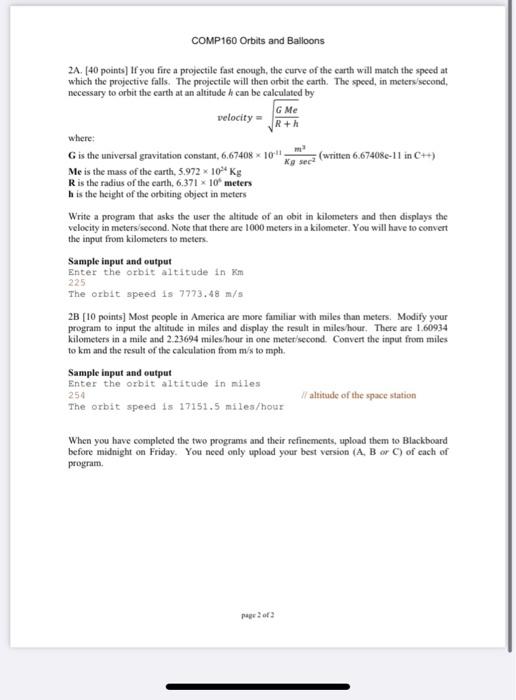Answered step by step
Verified Expert Solution
Question
1 Approved Answer
in c++ please COMP160 Orbits and Balloons 2A. [40 points) If you fire a projectile fast enough, the curve of the earth will match the
in c++ please 
COMP160 Orbits and Balloons 2A. [40 points) If you fire a projectile fast enough, the curve of the earth will match the speed at which the projective falls. The projectile will then orbit the carth. The speed, in meters second, necessary to orbit the earth at an altitude h can be calculated by G Me velocity R+ where: G is the universal gravitation constant, 6.67408*10** xe seca (written 6.67418e-11 in C++) Me is the mass of the earth, 5.972 * 10** Kg R is the radius of the earth. 6.371 * 10 meters h is the height of the orbiting object in meters Write a program that asks the user the altitude of an obit in kilometers and then displays the velocity in meters second. Note that there are 1000 meters in a kilometer. You will have to convert the input from kilometers to meters Sample input and output Enter the orbit altitude in Kim 225 The orbit speed 1s 7773.48 m/s 2B [10 points] Most people in America are more familiar with miles than meters. Modify your program to input the altitude in miles and display the result in miles/hour. There are 1.60934 kilometers in a mile and 2.23694 miles/hour in one meter second Convert the input from miles to km and the result of the calculation from m/s to mph. Sample input and output Enter the orbit altitude in miles 254 altitude of the space station The orbit speed 1s 17151.5 miles/hour When you have completed the two programs and their refinements, upload them to Blackboard before midnight on Friday. You need only upload your best version (A, B or C) of cach of program po 
Step by Step Solution
There are 3 Steps involved in it
Step: 1

Get Instant Access to Expert-Tailored Solutions
See step-by-step solutions with expert insights and AI powered tools for academic success
Step: 2

Step: 3

Ace Your Homework with AI
Get the answers you need in no time with our AI-driven, step-by-step assistance
Get Started


